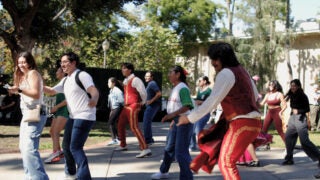Insider’s Guide to USC Village — from A to Z
From student life and Trojan traditions to restaurants and stores, we’ve got everything you need to know about the $700 million residential-retail project everyone’s been waiting for (and you can explore it below).
-

USC Village reflects Collegiate Gothic architecture, which includes elements of English Tudor design.
With a nod to the centuries-old, ivy-covered university campuses of Oxford and Cambridge, USC Village’s architectural flourishes evoke a sense of antiquity and grandeur, but the buildings are firmly grounded in the modern world with the latest technology and amenities.
Recessed, arched entryways are set off with decorative stone carvings and moldings. Paned windows abound, many with tracery featuring geometric patterns. Red-brick and cream-colored masonry ties USC Village visually to the rest of University Park Campus. Gothic arches and carved finials point toward the crowns of the 70-foot-tall buildings, while the McCarthy Honors College clock tower rises over the Central Piazza below, which includes Fubon Fountain and the Hecuba statue. Detailed but not overly ornate or fussy, the building facades honor academia, reflecting President C. L. Max Nikias’ vision for “the best and most timeless kind of human community.”
-
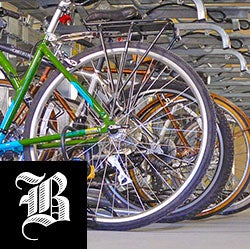
Bikes are a common sight on the University Park Campus, and at USC Village, no student’s bike has to spend the night outdoors. No students have to climb over bikes stashed in their rooms, either, thanks to bicycle garages built into the complex.
– Each residential building has an indoor bike garage at ground level.
– Garages can hold 1,272 bikes in all.
– Double-stacked racks allow for bikes to be lifted easily and locked away.
– Wash and repair stations are plentiful.
– 224 outdoor bike slots are available for visitors.
– Without a bike? Students can buy one at the new Solé Bicycles shop onsite.
-

Before USC Village opened, it was already changing lives.
“It’s always going to be here, and I can say I was part of it,” says Marcellous Bell, a carpenter who started working at the site in January 2016 and is one of thousands of local workers who built the complex.
Five years ago, he couldn’t have imagined being part of such an enormous project. Back then, he was on a different path. The talented high school football player had drifted into petty theft and fighting, and was once shot in the back. But he found support from a community group that helped him turn his life around and find a job at USC Village.
“I did a full 180. I’ve learned stuff here I didn’t even know I could do,” Bell says.
With the project completed, he’s proud of his work. Says Bell: “Someday I can say, ‘I helped put a roof over your head.’”
-
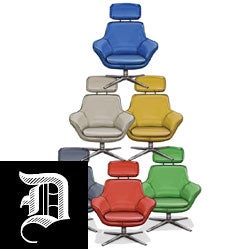
More than 12,000 pieces of residential furniture fill USC Village’s residence halls: dressers, beds, desks, tables, chairs and couches.
Most were made with some recycled material, and all were chosen for durability, simplicity and style after extensive testing. (Just one example: Staff sifted through a dozen models of desk chairs before picking one.)
“We tried to pick out flexible, modern furniture that incorporated colors from the building into each lounge,” interior designer Jan Edson says. “The color scheme for each building is based on landscapes, and you’ll see that echoed as you walk through the residential life lounges.”
-
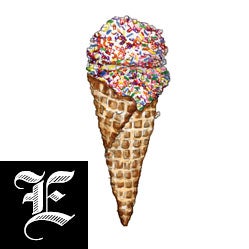
Hungry? More than a dozen restaurants are open to the public at USC Village, with more to come. And of course, there’s always fresh and affordable fare at the Honors Dining Hall at McCarthy Honors College.
USC Village’s new public offerings include healthful eating spots like Greenleaf Gourmet Chopshop and SunLife Organics; coffee purveyors Starbucks and Butcher, Baker, Cappuccino Maker; ice cream sandwich hotspot The Baked Bear; and plenty of restaurants dishing up Vietnamese, Italian, Mediterranean and Mexican food.
“We’re creating that experiential space where students can bump into professors, faculty and staff,” says Laurie Stone, associate senior vice president of university real estate and asset management. “Sharing coffee, breaking bread, talking about what you’re working on—that kind of idea creation allows for interdisciplinary activity.”
-

Thousands of undergraduates now live at USC Village. So do six faculty members.
Known as faculty in residence, these professors reinforce the special elements of USC’s residential college system. They share meals with students and plan events and trips, helping students build bonds with each other inside and outside the classroom.
Faculty in residence are spread across USC’s undergraduate housing, but USC Village has a half-dozen professors all to itself: Laura Baker, Ruth Chung, Broderick Leaks, John Pascarella, Neelesh Tiruviluamala and Trisha Tucker.
“We’re here to build authentic, caring relationships,” says Pascarella, an associate professor of clinical education who had been a faculty member in residence at South Residential College since 2012. “We want to connect students with alumni and cultivate a commitment to service, which aligns with our mission as a university.”
-
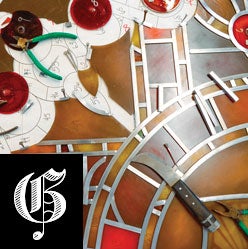
You can’t blame first-time visitors to USC Village when they’re taken in by the sheer scope of the massive $700 million residential-retail complex. But its beauty also lies in its details.
They’re apparent in the gem-colored light and muted shadows cast by USC Village’s handcrafted stained-glass windows. The windows star as the showpiece of the complex’s expansive dining area in McCarthy Honors College and offer a collegiate sensibility reminiscent of Harry Potter’s Hogwarts.
Created at Judson Studios in northeast Los Angeles, the windows give a glimpse into the university’s soul. It’s also fitting that the creators behind the windows—some of the nation’s most acclaimed glass artisans—have a history intertwined with USC.
-
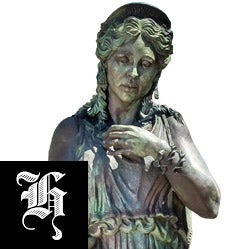
At USC Village, all paseos lead to the Central Piazza, which features a uniquely Trojan landmark that celebrates the women of Troy: a sculpture of Hecuba, the majestic queen of Troy.
Wife of King Priam, Hecuba took a stand to preserve and protect her family and beloved city. Her story lives on in classic works by Homer, Virgil and Euripides.
“In times of great grief and great joy, in times of trial and tribulation, in times of tragedy and triumph, it was Hecuba whose courage and compassion embodied the strength of spirit that is found within every Trojan,” USC President C. L. Max Nikias says.
The Hecuba statue rises gracefully more than 20 feet into the sky. Her figure stands atop a base sculpted with reliefs of six female figures who depict the ethnic diversity of USC in the 21st century.
-
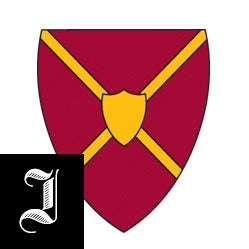
The symbols of heraldry have stood as marks of achievement for centuries. What’s old is now new, as USC draws on this history to shape the icons that represent its residential colleges.
Each USC residential college has its own crest. With the creation of eight new residential colleges at USC Village, the suite of crests now has swelled to 14. Every crest displays visual elements that hold special meaning.
The design for McCarthy Honors College, for example, is inspired by the intersecting walkways of McCarthy Quad. Symbols used in the crests often relate to the theme of the residential college or originate as elements from USC’s seal and shield. The crests remain true to the university’s official colors, upholding tradition and a sense of place and belonging.
-

USC Village brought construction jobs to South Los Angeles, as well as ongoing work in maintenance, retail, food service and more. Here’s a snapshot of how the project’s construction boosted employment:
5,600: Carpenters, electricians, painters, masons and other skilled tradesmen and women
2.6 million: Cumulative work hours
550: Average number of workers who worked onsite daily
38%: Proportion of workers who lived in the city of Los Angeles
>20%: Proportion of workers who lived within 5 miles of the project
-
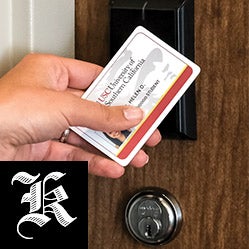
One less thing USC Village residents have to worry about: lost room keys.
Students use their ID cards to open their room doors and, if they live in a multi-bedroom unit, their individual bedroom doors. The cards also unlock the gates that protect USC Village’s perimeter, which are closed to the public overnight. The lobby of each building has a 24-hour staffed reception desk with fingerprint scanners and facial recognition monitors.
To summon elevators and go upstairs, residents must scan an ID card at the elevator bank. The measures ensure that in addition to student rooms, the private outdoor courtyards and lounges can only be accessed by building residents. These student-only areas are found throughout each residential college and were designed to provide a place for residents to socialize, study and relax.
-
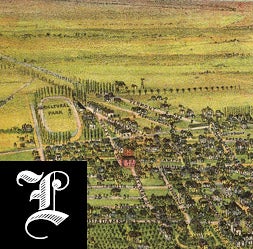
Long before there was USC Village, there was the land on which it now stands—scrubby and open. When the Spanish arrived to lay claim to California, indigenous people known as the Tongva (Gabrielino) inhabited the Los Angeles basin.
The original Spanish civilian settlement that would become the city of Los Angeles grew in the 1780s around the area today known as Olvera Street in downtown L.A. During the era of Spanish and Mexican ranchos, the long trip from El Pueblo de Los Angeles to the lonely site of the future USC was probably best attempted on horseback. After California was ceded to the United States, the land evolved from farmland into a thriving neighborhood and later a busy shopping area before becoming the site of USC Village today.
-
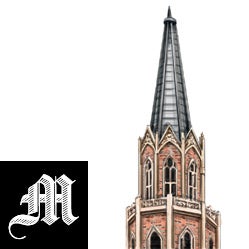
The Kathleen L. McCarthy Honors College is now home to first-year students who are among the nation’s brightest. In 2014, the Thomas and Dorothy Leavey Foundation, chaired by USC Trustee Kathleen Leavey McCarthy ’57, donated $30 million to the university, making it possible to integrate USC’s undergraduate scholarship and honors programs and establish a community of exceptional scholars at the residential college.
McCarthy Honors College houses nearly 600 freshman scholars and offers exclusive academic, cultural and social activities. Students receive regular mentoring from two members of the faculty in residence and an extensive residential education staff, who coordinate weekly themed discussions with guest speakers. Other activities include presentations from USC faculty and visiting scholars.
-
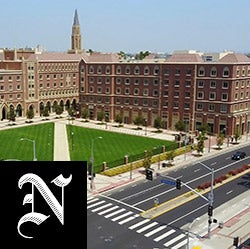
The biggest mixed-use development project ever in South L.A. history, USC Village welcomes its neighbors to enjoy its open piazzas and offers green space for anyone interested in strolling and relaxing in public areas.
The complex’s retail outlets—including Trader Joe’s and Target—offer healthful food and everyday essentials. More than 460 public parking spaces are available to shoppers in an underground lot. A community room was built to host local events and gatherings, as well. Neighbors also benefit from the street improvements along Jefferson Boulevard, including wider sidewalks, bike lanes and more crosswalks, some of which have been updated to allow for safer pedestrian crossings.
USC Village also brings the community jobs at its residence halls, shops and restaurants. With 2,500 beds for students, USC Village frees up rental housing space for the community, as more students live on campus rather than in nearby apartments. USC also invested $20 million in affordable housing funds for the neighborhood and opened a free legal clinic providing help for South L.A. residents needing housing and landlord-tenant dispute resolution.
-
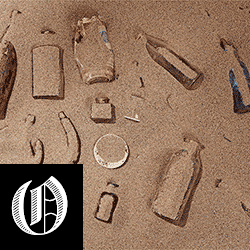
Excavate 15 acres of land, and you’re bound to find an object someone left behind.
USC Village construction workers acted as contemporary archaeologists, salvaging mysterious detritus they discovered during the project. Among their odd “treasures” were intricate glass bottles, a few horseshoes and a railroad spike. No one knows their provenance, now lost to the shifting sands of Los Angeles history.
-

More than a million bricks went into the construction of USC Village, but it was the generosity of the Trojan Family that built it.
USC trustees, alumni, Trojan parents and friends from around the world stepped forward to make USC Village possible. Their words echo those of USC Trustee Kathleen Leavey McCarthy ’57, who has given to USC for many years to support improvements across the university.
“Seeing the university evolve over the years has been nothing but a joyful experience,” says McCarthy, whose latest gift created a new residential honors college for exceptional freshmen at USC Village.
McCarthy is one example of the many people who have celebrated the rise of USC and helped make it happen through their giving. Thanks to gifts of all sizes, USC now offers an unparalleled living-learning program—a key factor in recruiting the highest caliber students.
-

With so many floor plans and more than 2,500 beds at USC Village, residents have plenty of room configurations to choose from.
Some suites accommodate two people, while others fit as many as eight. One common option is a four-person unit, which has several floor plan options throughout the residential colleges, including suites with two rooms or four rooms, floor-level or lofted beds, and other variations.
Curious? Explore students’ options at housing.usc.edu.
-
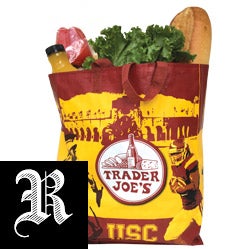
New shops and stores offer more than 100,000 square feet of retail space and choices for USC students and South L.A., with plenty of parking.
Here’s a sampling (and check out the latest full listing online at usc-village.edu): Target, Trader Joe’s (a first in the neighborhood), Bank of America, Starbucks and Village Cobbler—a shop that returned from University Village.
-

“USC Village will no longer be adjacent to campus. It will be the campus.” So said USC President C. L. Max Nikias at its groundbreaking.
USC Village’s construction logistics and materials alone made the sheer scale of the project unprecedented in the university’s history. Here are a few of the numbers:
1,124 days: USC Village project duration (June 2, 2014 – July 1, 2017)
896 days: Construction duration
1.2 million: Miles of wire used
1.4 million: Bricks used
100,000 cubic yards: Concrete poured
23 million: Pounds of rebar used
-
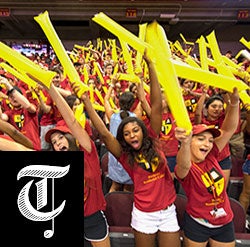
USC Village is just one of the ways USC has elevated student life.
Undergrads today find residential colleges that have been reinvented. They aren’t just places to live—they’re learning communities. There’s more to do, more ways to make friends, more ways to feel connected, and more traditions to bind Trojans together.
Take the Residential College Cup. The year-long competition, started in 2016, pits residential colleges for first-year students against each other in activities like intramural sports and trivia nights. Birnkrant took home the first Residential College Cup. This fall, the six original colleges face even stiffer competition as USC Village’s McCarthy Honors College joins in.
-

Eight new residential colleges are housed within five of USC Village’s six buildings, creating not only a new home, but also new ways to learn for more than 2,500 undergraduates.
The first new campus housing complex in a decade, USC Village holds 663 residential college units: 518 suites with kitchens and another 145 without them. Also onsite is a substation of USC’s Department of Public Safety, which is staffed 24 hours a day.
The addition of USC Village expands undergraduate housing across USC by 24 percent. About 9,200 students, both undergraduate and graduate, can now live in USC housing. Space at other USC housing facilities was reconfigured to accommodate many more graduate students and students with families, spreading the benefits of USC Village beyond Trojan undergraduates.
-
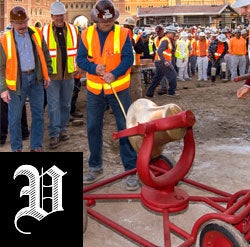
Trojan fans and alumni weren’t the only ones celebrating USC football’s 2016 win over UCLA. Hundreds of USC Village construction working at USC Village also took part in the victory.
With help from USC football head coach Clay Helton, hundreds of workers jumped at the chance to ring the Victory Bell, the traditional trophy for the winner of the fierce crosstown rivalry.
“I really felt the Trojan spirit,” said construction worker Ruben Ortiz at the time. “I’ve always been a Trojan fan. It was great for the head coach to come out here and support our work.”
-
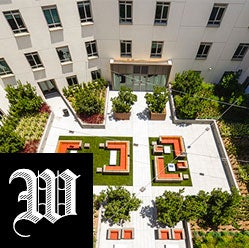
USC Village’s broad paseos converge at the tree-lined Central Piazza at the core of the complex. The patterned red bricks and concrete paving in the plaza, which cover almost the area of a football field, echo the design of the space’s sister site, Hahn Plaza.
The park-like environment offers up decisions: walk awhile, or sip a cup of coffee? As visitors stroll from Fernow and McMaster Plaza down Holoman Way, they look up at USC Village’s facades through a leafy filter.
About 390 trees now grow at USC Village, including a 30-foot-tall California live oak that provides a serene backdrop for the plaza’s sculpture of Hecuba. Wider sidewalks accommodate the heavier foot traffic around USC Village, too. Jefferson Boulevard street parking in front of USC Village has been eliminated and replaced with bike lanes. Bike lanes are now available on all the streets bordering the complex.
-

The $700 million USC Village complex increases the area of the University Park Campus by 1.25 million square feet. But beyond the numbers, its impact on the campus culture, academics and student life is a game changer—the X-factor that will shape USC in the decades ahead.
-
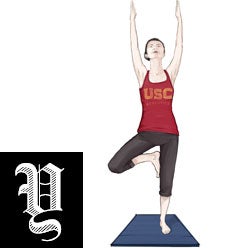
Step into the 30,000- square-foot USC Village Fitness Center and you might feel compelled to breathe deeply and stretch. The center is designed for that, with plenty of natural light and open space for those inspired to try some cardio or dance moves.
The fitness center’s clean, contemporary design serves as the backdrop for about a hundred cardio stations, including treadmills, stationary bikes and rowing machines. Resistance machines abound. So do flat-screen displays. Spacious group-fitness rooms support a full schedule of cardio, yoga, muscle conditioning and body sculpting classes. With the new gym and renovations to the Lyon Center, the Trojan community now has more space to exercise indoors on USC’s campuses.
“This will transform the way students can utilize recreation at the university,” says Justine Gilman, director of recreational sports. “It’s the biggest opportunity we’ve had to increase workout space since the Lyon Center opened in 1989.”
-

USC Village moves the northern border of the University Park Campus from Jefferson Boulevard to 30th Street—and it’s a seamless transition.
Sight lines, walkways and architectural elements were all carefully designed to connect USC Village visually across Jefferson Boulevard to the rest of campus, so that no matter where you are, it always looks and feels like one USC. The hundreds of students living in USC Village even share the same zip code that students living at the University Park Campus have long had: 90007.

